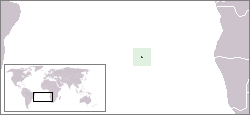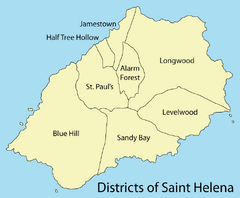Saint Helena /sɪnt hɛlənə/ (Helenese dialect: Synnt Elina /sɪnt iːlɪnə/) is an island in the southern Atlantic Ocean. Formerly a British colony, today it is an overseas colony of the Dominion of South Africa that enjoys a high level of autonomy.
History[]
Colonization[]
In 1657, the English East India Company was granted a charter to govern St. Helena by Oliver Cromwell, and the following year the Company decided to fortify the island and colonise it with planters. The first governor, Captain John Dutton, arrived in 1659, and it is from this date that St. Helena claims to be Britain’s second oldest colony (after Bermuda). A fort was completed and a number of houses were built. After the restoration of the English monarchy in 1660, the East India Company received a Royal Charter giving it the sole right to fortify and colonise the island. The fort was renamed James Fort and the town Jamestown, in honour of the Duke of York, later James II of England. The Company experienced great difficulty attracting new immigrants, and unrest and rebellion fermented among the inhabitants. Ecological problems, including deforestation, soil erosion, vermin and drought, led governor Isaac Pyke to suggest in 1715 that the population should be moved to Mauritius, but this was not acted upon and the Company continued to subsidise the island because of its strategic location. A census in 1723 showed a total population of 1,110, including 610 slaves.
Under the provisions of the 1833 India Act, control of St. Helena was passed from the East India Company to the British Crown. Subsequent administrative cost-cutting triggered the start of a long-term population decline whereby those who could afford to do so tended to leave the island for better opportunities elsewhere. The latter half of the 19th century saw the advent of steamships not reliant on trade winds, as well as the diversion of Far East trade away from the traditional South Atlantic shipping lanes to a route via the Red Sea (which, prior to the building of the Suez Canal involved a short overland section). These factors contributed to a decline in the number of ships calling at the island from 1,100 in 1855 to only 288 in 1889.
In 1840, a British naval station established to suppress the African slave trade was based on the island, and between 1840 and 1849 over 15,000 freed slaves, known as "Liberated Africans" were landed there. In 1900 and 1901, over 6,000 Boer prisoners were held on the island, and the population reached its all-time record of 9,850 in 1901.
The British Nationality Act 1981 reclassified St. Helena and the other Crown colonies as British Dependent Territories. The islanders lost their status as "Citizens of the United Kingdom and Colonies" and were stripped of their right of abode in Britain.
Isolation[]
The nuclear attacks of 1983 cut the island off from its usual sources of supplies. Nothing came from Britain for many years. Desperate especially for fuel and medical supplies, the islanders organized some runs to Walvis Bay, South Africa; but regular contact with the outside world was essentially cut off. The islanders had to make do, living off the land and the sea.
The first relief came in 1987 from a contingent of the Royal Navy that had traveled to Port Elizabeth to protect a group of British refugees, including King Andrew. The navy at this point had not quite given up on the idea of Britain, and they organized relief expeditions to Saint Helena and some other islands of the British Atlantic. Some of the islanders decided to leave for South Africa at this time, though some would eventually return.
South African dependency[]
In 1989 the Dominion of South Africa declared that it was taking control of the remaining British islands in the South Atlantic. This merely formalized the existing relationship, since all these islands now thoroughly depended on the DSA for survival. The islands were also reorganized: Tristan Da Cunha and Ascension Island were to be fully autonomous territories, not dependencies of Saint Helena.
The people of Saint Helena formalized this new arrangement in 1990 with an island-wide referendum. The territory declared its loyalty to the king and Dominion but asserted wide autonomy, including the retention of the Union Flag and the power to elect its own governor. The DSA had little choice but to accept these demands.
In 1995, King Andrew launched the replacement RMS St. Helena to serve the island; the vessel was specially built for the Cardiff–Cape Town route and features a mixed cargo/passenger layout. This helped to further strengthen ties between the two nations.
Politics[]
Executive authority in St. Helena is invested in the monarch and is exercised on his behalf by the Governor of St. Helena. The Governor is elected by the people of St. Helena instead of being appointed by the monarch as they were before 1983.
There are 15 seats in the Legislative Council, a unicameral legislature. 12 of the 15 members are elected in elections held every four years. The other three members are the Governor and two ex-officio officers. The Executive Council consists of the Governor, two ex-officio officers, and six elected members of the Legislative Council appointed by the Governor. There is no elected Chief Minister, and the Governor acts as the head of government. In 2007, Governor Andrew Gurr succeeded Michael Clancy.
Culture[]
With Britain gone and outside contact reduced, the "Saints" have come to appreciate their own nationhood, represented above all by the new term Helenese. The Helenese ethnicity is of mixed origins, descended from British, enslaved Africans, and Chinese laborers. They have also embraced their dialect of English. Some common Helenese phrases include:
- Ouw yuo dooen emayt? /aʊw juːəʊ duːn iːmeɪt/ - How are you doing mate? /haʊ ɑː juː duːɪŋ meɪt/
- Ay sheek Elineess /eɪ ʃiːk iːlaɪniːs/ - I speak Helenese /aɪ spiːk hɛləniːz/
| ||||||||||||||||||||||





